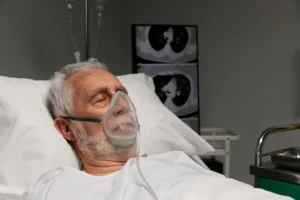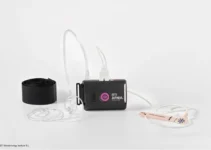CPAP ventilation, or Continuous Positive Airway Pressure, is a common therapy employed to treat individuals struggling with obstructive sleep apnea. This medical device ensures that the airways remain open during sleep by delivering a steady flow of air through a mask, which prevents the collapse of airways and helps patients achieve uninterrupted breathing. As sleep apnea can lead to various health complications if left untreated, understanding how CPAP machines function and their benefits is crucial for those affected by this condition.
What is CPAP Ventilation?
Continuous Positive Airway Pressure (CPAP) ventilation is a common therapy used for individuals suffering from obstructive sleep apnea (OSA). This condition, characterized by repetitive interruptions in breathing during sleep, can lead to a variety of health issues if left untreated. CPAP ventilation ensures that these interruptions are minimized by providing a steady stream of air pressure to keep the airways open during sleep.
The effectiveness of CPAP therapy has been well documented in numerous studies. Patients who consistently use CPAP machines often experience significant improvements in sleep quality, daytime alertness, and overall health. By maintaining an open airway, CPAP therapy not only enhances sleep but also reduces the risk of cardiovascular problems associated with untreated OSA.
In recent years, advancements in CPAP technology have made these machines more comfortable and easier to use. Modern CPAP devices are quieter, more compact, and equipped with features that cater to the specific needs of patients, making the therapy much more accessible and effective.
Definition of CPAP Ventilation
CPAP ventilation is a non-invasive therapy that delivers a continuous stream of air into a patient’s airway. This stream of air creates a pressure that prevents the airway from collapsing, which is a common occurrence in people with obstructive sleep apnea. By keeping the airway open, CPAP helps to normalize breathing patterns during sleep. The term “continuous” in CPAP refers to the fact that the air pressure is delivered at a constant level, as opposed to varying with the patient’s breathing cycle. This continuous pressure ensures that the airway remains open throughout the sleep cycle, reducing episodes of apnea and hypopnea.
Components of a CPAP Machine
A standard CPAP machine consists of several key components that work together to deliver effective therapy. The main parts include:
- The motor: This is the core of the machine, generating air at a prescribed pressure.
- The tubing: This flexible tube connects the motor to the mask, carrying the pressurized air.
- The mask: This part fits over the patient’s nose or mouth, or both, and is responsible for delivering the air directly into the airways.
- The humidifier: Some CPAP machines come with an integrated humidifier to moisten the air and prevent dryness and irritation in the airway.
These components work in unison to ensure that the patient receives consistent and comfortable air pressure throughout the night. The quality and fit of the mask are particularly important, as a poor fit can lead to air leaks and reduced effectiveness of the therapy.
Modern CPAP machines may also include a variety of features such as ramp settings, which gradually increase the air pressure to the prescribed level, and data recording capabilities, which allow healthcare providers to monitor the patient’s usage and adjust settings as needed.
How CPAP Ventilation Works
CPAP ventilation operates on the principle of providing a steady stream of pressurized air to keep the airway open. When the patient inhales, the air pressure prevents the tissues in the throat from collapsing, which is a common cause of obstructive sleep apnea. By doing so, it ensures that the patient can breathe easily throughout the night.
When the patient exhales, some CPAP machines are equipped with features that reduce the pressure slightly to make breathing out more comfortable. This balance of pressure adjustments helps in maintaining a natural breathing rhythm, enhancing overall comfort and compliance with therapy.
The effectiveness of CPAP therapy largely depends on the regular and consistent use of the device. Studies have shown that patients who use their CPAP machines for at least four hours per night show significant improvements in sleep quality and daytime function.
It is also crucial for patients to undergo periodic follow-ups with their healthcare providers to monitor the effectiveness of the therapy. Adjustments in pressure settings, mask type, or other features may be necessary to ensure optimal treatment outcomes.
If you’re interested in learning more about CPAP ventilation and other related topics, be sure to check out our other articles for more in-depth information.
CPAP Ventilation in Sleep Apnea Treatment
Continuous Positive Airway Pressure (CPAP) is one of the most commonly prescribed treatments for sleep apnea. Sleep apnea is a condition characterized by repeated interruptions in breathing during sleep, which can lead to serious health problems such as cardiovascular disease, diabetes, and daytime fatigue. CPAP therapy involves wearing a mask over the nose and/or mouth that provides a continuous stream of air to keep the airways open during sleep.
The importance of CPAP therapy in managing sleep apnea cannot be overstated. It not only improves the quality of sleep but also significantly reduces the associated health risks. Studies have shown that consistent use of CPAP can lead to better blood pressure control, a lower risk of heart disease, and improved overall health and quality of life.
In this article, we will explore the role of CPAP in treating sleep apnea, its effectiveness, and the potential side effects that users may experience. Understanding these aspects can help patients and healthcare providers make informed decisions about the use of CPAP therapy.
Role of CPAP in Treating Sleep Apnea
CPAP therapy works by delivering a constant and steady air pressure through a mask, which prevents the airway from collapsing and allows for normal breathing during sleep. The positive airway pressure ensures that the upper airway remains open, which is crucial for individuals with obstructive sleep apnea (OSA), the most common type of sleep apnea.
The role of CPAP in treating sleep apnea extends beyond just preventing airway obstruction. It also helps in reducing the number of apneas (pauses in breathing) and hypopneas (shallow breathing) that occur during the night. By doing so, CPAP therapy improves the oxygen levels in the blood and reduces the strain on the cardiovascular system.
Numerous studies have demonstrated the effectiveness of CPAP in reducing the severity of sleep apnea symptoms. The American Academy of Sleep Medicine recommends CPAP as the first-line treatment for moderate to severe OSA. The therapy has been proven to help alleviate daytime sleepiness, improve cognitive function, and enhance the overall quality of life for patients.
Effectiveness of CPAP Therapy
The effectiveness of CPAP therapy in treating sleep apnea has been extensively studied and documented. Research indicates that CPAP is highly effective in reducing the Apnea-Hypopnea Index (AHI), which measures the severity of sleep apnea. Patients who adhere to CPAP therapy experience a significant reduction in AHI, leading to better sleep quality and reduced daytime fatigue.
One of the key factors contributing to the effectiveness of CPAP therapy is patient compliance. Studies show that patients who use CPAP consistently for at least 4 hours per night experience the most significant benefits. Compliance can be influenced by several factors, including comfort of the mask, pressure settings, and patient education.
In addition to improving sleep quality, CPAP therapy has been shown to have positive effects on overall health. Regular use of CPAP can help lower blood pressure, reduce the risk of heart attack and stroke, and improve insulin sensitivity in patients with type 2 diabetes. These benefits are crucial in managing the long-term health risks associated with sleep apnea.
It is important for patients to work closely with their healthcare providers to optimize their CPAP therapy. Regular follow-ups, adjustments to pressure settings, and addressing any discomfort or side effects can enhance the effectiveness of the treatment and improve patient compliance.
Potential Side Effects of CPAP Use
While CPAP therapy is highly effective, some patients may experience side effects. Common side effects include nasal congestion, dry mouth, and skin irritation from the mask. These issues can often be resolved through adjustments to the mask fit, use of a humidifier, or changes in pressure settings.
In some cases, patients may experience more serious side effects such as claustrophobia or discomfort due to the pressurized air. It is important for patients to communicate any issues they encounter to their healthcare provider, who can make necessary adjustments or suggest alternative treatments if needed.
Another potential side effect is aerophagia, which is the swallowing of air that can lead to bloating and discomfort. This can often be managed by adjusting the pressure settings on the CPAP machine or using a different type of mask.
Despite these potential side effects, the benefits of CPAP therapy in managing sleep apnea far outweigh the drawbacks. Most side effects can be effectively managed with proper guidance and support from healthcare providers. For many patients, the improvement in sleep quality and overall health makes CPAP therapy a worthwhile investment.
In conclusion, CPAP ventilation plays a crucial role in the treatment of sleep apnea. Its effectiveness in reducing symptoms and improving health outcomes has been well-documented. However, as with any medical treatment, it is important to be aware of potential side effects and to work closely with healthcare providers to ensure the best possible outcome. For more insights on sleep health and other related topics, explore our other articles!
Getting Started with CPAP Therapy
Continuous Positive Airway Pressure (CPAP) therapy is a highly effective treatment for obstructive sleep apnea (OSA). It involves wearing a device that uses mild air pressure to keep the airways open during sleep. This therapy can help reduce daytime fatigue, improve heart health, and enhance overall quality of life. Understanding the basics of CPAP therapy is crucial for ensuring its success and addressing common challenges that users may face.
When starting CPAP therapy, it’s important to have a clear diagnosis from a sleep specialist. This usually involves a sleep study to determine the severity of the sleep apnea. Once diagnosed, your doctor will recommend a CPAP machine, mask, and pressure settings tailored to your specific needs. Adhering to your prescribed treatment is essential for achieving the best possible outcomes.
Getting used to CPAP therapy can take some time, but with the right support and equipment, most patients can successfully adapt. Consistency and patience are key. Initially, you may feel discomfort or struggle with the mask, but with proper guidance and a willingness to make adjustments, you can overcome these hurdles. Regular follow-ups with your healthcare provider can help address any ongoing issues and improve your therapy experience.
Choosing the Right CPAP Machine
Selecting the appropriate CPAP machine is a critical step in starting therapy. There are several types of CPAP machines available, including standard CPAP, BiPAP (Bi-level Positive Airway Pressure), and APAP (Auto-adjusting Positive Airway Pressure). Each type has its own advantages and is suitable for different severity levels and personal preferences. Consulting with your sleep specialist will help determine which machine is best for you.
When choosing a CPAP machine, consider features that align with your lifestyle and needs. Noise level, portability, and humidification options are important factors to evaluate. Modern CPAP machines come with advanced features such as ramp settings to gradually increase pressure and data tracking to monitor therapy effectiveness. These features can enhance comfort and encourage regular use.
The mask is another crucial component of your CPAP setup. Masks come in various styles, including nasal masks, full-face masks, and nasal pillows. Finding a mask that fits well and is comfortable to wear can make a significant difference in your therapy adherence. It’s often helpful to try different mask types to see which one works best for you. Many suppliers offer trial periods to help you make an informed decision.
Finally, consider the ease of maintenance and availability of support for the CPAP machine you choose. Regular cleaning and filter changes are necessary to ensure the device functions properly and remains hygienic. Additionally, having access to customer support can be invaluable for troubleshooting any issues that arise during your therapy.
If you’re interested in learning more about CPAP therapy and other related topics, be sure to check out our other articles. With a wealth of information available, you can empower yourself to achieve better sleep and overall health.
Tips for CPAP Therapy Success
Continuous Positive Airway Pressure (CPAP) therapy is a crucial treatment for those suffering from obstructive sleep apnea (OSA). However, achieving success with CPAP therapy requires more than just using the machine every night. Proper usage, regular maintenance, and overcoming common obstacles can significantly impact the effectiveness of CPAP therapy and overall health outcomes. By following some essential tips, users can enhance their CPAP experience and ensure optimal therapeutic results.
Research has shown that adherence to CPAP therapy not only reduces the symptoms of sleep apnea but also improves cardiovascular health, cognitive function, and overall quality of life. For new users, the process can be daunting, but with the right approach, the transition to CPAP therapy can be smooth and rewarding.
In this article, we will explore various tips for CPAP therapy success, focusing on ensuring a proper CPAP mask fit, maintaining equipment, and addressing common challenges that users may encounter. By understanding and implementing these strategies, individuals can maximize the benefits of their CPAP therapy.
Proper CPAP Mask Fit
One of the most critical factors in CPAP therapy success is ensuring a proper mask fit. A mask that fits well will not only provide comfort but also ensure the efficiency of the therapy. An ill-fitting mask can lead to air leaks, skin irritation, and discomfort, making it less likely for the user to adhere to the therapy.
To achieve a proper fit, consider the following tips:
- Choose the right type of mask: Nasal masks, full-face masks, and nasal pillow masks are the most common types. Each has its advantages and finding the right one depends on your breathing habits and comfort preferences.
- Adjust the straps: Ensure that the mask’s straps are snug but not too tight. Overly tight straps can cause pressure sores, while loose straps can lead to air leaks.
- Trial and error: It might take a few tries to find the perfect fit. Don’t hesitate to experiment with different masks and sizes to find the one that works best for you.
Consult with your healthcare provider or a CPAP technician for personalized advice on finding the right mask. Their expertise can help prevent common issues related to poor mask fit and ensure a more comfortable and effective therapy experience.
Maintaining Your CPAP Equipment
Regular maintenance of your CPAP equipment is essential for both hygiene and functionality. Proper care will not only extend the lifespan of your equipment but also ensure that your therapy remains effective.
Here are some key maintenance tips:
- Daily Cleaning: Clean your mask, tubing, and water chamber daily using mild soap and warm water. This helps to prevent the build-up of germs and bacteria.
- Replace Filters: CPAP machines come with filters that need to be replaced regularly. Check your machine’s manual for specific guidelines on how often to replace these filters.
- Inspect for Wear and Tear: Regularly inspect your mask, tubing, and headgear for any signs of wear and tear. Replace any worn-out parts immediately to maintain optimal performance.
Staying on top of your CPAP equipment maintenance can prevent potential issues and ensure a more pleasant and effective therapy experience. Always follow the manufacturer’s recommendations and consult your healthcare provider for additional maintenance advice.
Overcoming Common CPAP Issues
Even with proper mask fitting and regular maintenance, CPAP users may encounter common issues that can hinder their therapy. Being aware of these issues and knowing how to address them can make a significant difference.
Some common CPAP issues and solutions include:
- Dry Mouth: This can be addressed by using a humidifier with your CPAP machine. Adjusting the humidity level can help alleviate dryness.
- Nasal Congestion: If you experience nasal congestion, a saline nasal spray or switching to a full-face mask could help.
- Sore or Dry Eyes: Ensure your mask is properly fitted to avoid air leaks that might be causing sore or dry eyes.
- Difficulty Adapting: Gradually increase your usage time and ensure your mask is comfortable. Discuss any concerns with your healthcare provider for tailored solutions.
By proactively addressing these common issues, CPAP users can improve their comfort and adherence to therapy, ultimately enhancing their overall health and quality of life.
For those looking to delve deeper into the intricacies of CPAP therapy and related topics, consider exploring additional articles that cover advanced techniques, latest technological advancements, and expert tips for optimizing sleep health.
Common Queries About CPAP Ventilation
For those exploring options for sleep apnea treatment, understanding CPAP ventilation is essential. Here’s a frequently asked question that might provide more clarity.
What is CPAP ventilation and how does it help in treating sleep apnea?
CPAP (Continuous Positive Airway Pressure) ventilation is a treatment method used primarily for individuals suffering from sleep apnea, particularly Obstructive Sleep Apnea (OSA). CPAP machines function by delivering a steady stream of pressurized air through a mask, which helps keep the airway open during sleep. This continuous airflow prevents the pauses in breathing characteristic of sleep apnea, thereby improving sleep quality and reducing health risks associated with the condition.

My name is Salman Kapa, a 73-year-old expert in bone regeneration and dental implantology. With decades of experience in the field, I am dedicated to advancing our understanding of oral health and hygiene. Through my research and writing, I aim to contribute to the development of innovative solutions in dental care.




